
Press Release
Prime Minister and the First Lady of Lesotho visit UNAIDS
24 October 2018 24 October 2018GENEVA, 24 October 2018—The Prime Minister Thomas Thabane and the First Lady of Lesotho, Maesaiah Thabane, visited UNAIDS headquarters in Geneva, Switzerland, to advocate for the end of AIDS and reduce its impact on young people.
They met the Executive Director of UNAIDS, Michel Sidibé, and UNAIDS staff members.
Around one in six people in Lesotho is living with HIV, one of the highest rates in the world. And more women are affected than men—27.7% of women are living with HIV, while 19.7% of men are. Progress has been made, with AIDS-related deaths declining from 15 000 in 2005 to about 5000 in 2017, but more needs to be done to prevent new HIV infections, notably from mother to child, with the mother-to-child transmission of HIV rate standing at 11.3%.
“We can and we will end new HIV infections among babies,” said Mr Thabane.
The First Lady meanwhile has been a champion of young people. She has shown strong commitment to reducing breast cancer and cervical cancer and pushing access to integrated reproductive health services.
“If we want to reduce and end gender-based violence against women, we must send our girls to school and keep them there,” said Ms Thabane. “We must invest in girls.”
Mr Sidibé expressed his full support, praising Lesotho for making significant progress in its HIV response. He said, “Ending AIDS begins with young people. That means engaging girls and boys and providing them with information through traditional and social media channels.”
UNAIDS
The Joint United Nations Programme on HIV/AIDS (UNAIDS) leads and inspires the world to achieve its shared vision of zero new HIV infections, zero discrimination and zero AIDS-related deaths. UNAIDS unites the efforts of 11 UN organizations—UNHCR, UNICEF, WFP, UNDP, UNFPA, UNODC, UN Women, ILO, UNESCO, WHO and the World Bank—and works closely with global and national partners towards ending the AIDS epidemic by 2030 as part of the Sustainable Development Goals. Learn more at unaids.org and connect with us on Facebook, Twitter, Instagram and YouTube.
Region/country

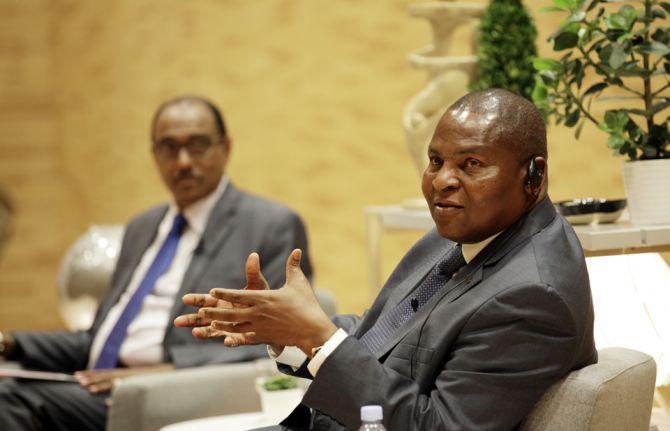
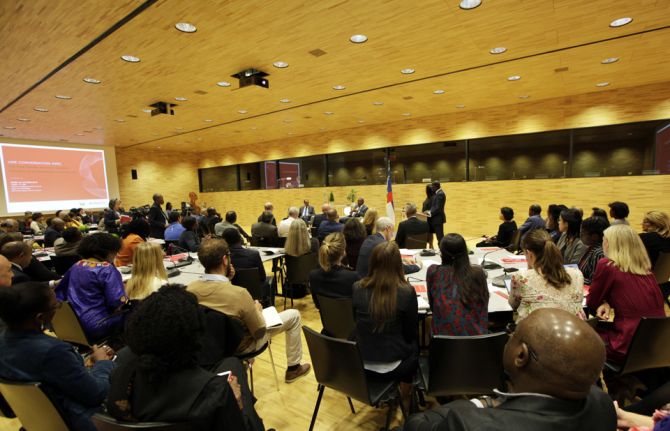
Press Release
The President of the Central African Republic commits to increasing access to basic social services
23 October 2018 23 October 2018UNAIDS' support to Central African Republic lauded by the President
GENEVA, 23 October 2018—The President of the Central African Republic visited UNAIDS to discuss ongoing efforts to rebuild his country, advance national reconciliation and deliver basic services for the populations after decades of political instability and conflict.
"The government is working with its partners to increase access to basic social services like education, health, and clean water as well as boost our HIV response,” said Faustin-Archange Touadéra, President of the Central African Republic. “Our progress remains fragile, this is why we need the support and engagement of all our partners to advance our recovery.”
UNAIDS Executive Director, Michel Sidibé, who visited CAR in early October, thanked the President for his continued commitment towards peace, saying he was encouraged to see pockets of hope. “In your reconstruction efforts, health is a powerful tool to improve social justice and stability,” said Mr Sidibé. “I commend the President for his personal engagement to ensure protection and dignity for all, including women and girls who are vulnerable to sexual violence and abuse.”
UNAIDS and the CAR Ministry of National Defence and Reconstruction of the Army and the Ministry of Health signed a memorandum of understanding (MoU) to reduce gender-based violence and HIV infections within the military and other uniformed personnel, and to increase uptake of HIV treatment, care and support services.
The Central African Republic has the second highest HIV prevalence in central Africa, estimated at 4% in 2017. However, among uniformed personnel, HIV prevalence is double, at an estimated 7.8%. Knowledge of HIV among uniformed personnel in the Central African Republic is particularly low and reports of sexual abuse and violence by military personnel are widespread. Since January 2017, the Central African Republic has seen progress in its response to HIV, with more than 10 000 people accessing life-saving treatment.
The President reiterated that after years of violence, people longed for an end to the suffering. He sincerely hopes that uniformed personnel, armed groups and the government will continue their dialogue to achieve peace with the African Union’s guidance. He repeated, “Now is the time to act to lift up our nation and we thank UNAIDS for their ongoing support.”
HIV data for the Central African Republic in 2017
- 160 000 [130 000–190 000] people were living with HIV
- 53% of people living with HIV knew their HIV status
- 32% of people living with HIV were accessing antiretroviral therapy
- 8700 [7600–11 000] people became newly infected with HIV
- 15 000 [12 000–17 000] people died from AIDS-related illnesses
UNAIDS
The Joint United Nations Programme on HIV/AIDS (UNAIDS) leads and inspires the world to achieve its shared vision of zero new HIV infections, zero discrimination and zero AIDS-related deaths. UNAIDS unites the efforts of 11 UN organizations—UNHCR, UNICEF, WFP, UNDP, UNFPA, UNODC, UN Women, ILO, UNESCO, WHO and the World Bank—and works closely with global and national partners towards ending the AIDS epidemic by 2030 as part of the Sustainable Development Goals. Learn more at unaids.org and connect with us on Facebook, Twitter, Instagram and YouTube.
Region/country


Press Release
Global health organizations commit to new ways of working together for greater impact
16 October 2018 16 October 2018BERLIN, GERMANY, 16 October 2018—Eleven heads of the world’s leading health and development organizations today signed a landmark commitment to find new ways of working together to accelerate progress towards achieving the United Nations’ Sustainable Development Goals.
Coordinated by the World Health Organization, the initiative unites the work of 11 organizations, with others set to join in the next phase.
The commitment follows a request from Chancellor Angela Merkel of Germany, President Nana Addo Dankwa Akufo-Addo of Ghana, and Prime Minister Erna Solberg of Norway, with support from United Nations Secretary-General Antonio Guterres, to develop a global plan of action to define how global actors can better collaborate to accelerate progress towards the health-related targets of the 2030 Sustainable Development Agenda.
“Healthy people are essential for sustainable development – to ending poverty, promoting peaceful and inclusive societies and protecting the environment. However, despite great strides made against many of the leading causes of death and disease, we must redouble our efforts or we will not reach several of the health-related targets,” the organizations announced today at the World Health Summit in Berlin. “The Global Action Plan for Healthy Lives and Well-being for All represents an historic commitment to new ways of working together to accelerate progress towards meeting the 2030 goals. We are committed to redefine how our organizations work together to deliver more effective and efficient support to countries and to achieve better health and well-being for all people.”
The group has agreed to develop new ways of working together to maximize resources and measure progress in a more transparent and engaging way. The first phase of the plan’s development is organized under three strategic approaches: align, accelerate and account.
- Align: The organizations have committed to coordinate programmatic, financing and operational processes to increase collective efficiency and impact on a number of shared priorities such as gender equality and reproductive, maternal, newborn, child and adolescent health.
- Accelerate: They have agreed to develop common approaches and coordinate action in areas of work that have the potential to increase the pace of progress in global health. The initial set of seven “accelerators” include community and civil society engagement, research and development, data and sustainable financing.
- Account: To improve transparency and accountability to countries and development partners, the health organizations are breaking new ground by setting common milestones for nearly 50 health-related targets across 14 Sustainable Development Goals. These milestones will provide a critical checkpoint and common reference to determine where the world stands in 2023 and whether it is on track to reach the 2030 goals.
The Global Action Plan will also enhance collective action and leverage funds to address gender inequalities that act as barriers to accessing health, and to improve comprehensive quality health care for women and girls, including sexual and reproductive health services.
The organizations that have already signed up to the Global Action Plan for Healthy Lives and Well-being for All are: Gavi the Vaccine Alliance, the Global Fund to Fight AIDS, Tuberculosis and Malaria, the Global Financing Facility, UNAIDS, UNDP, UNFPA, UNICEF, Unitaid, UN Women, the World Bank and WHO. The World Food Programme has committed to join the plan in the coming months.
The final plan will be delivered in September 2019 at the United Nations General Assembly.
For more information, www.who.int/sdg/global-action-plan
Media enquiries
- Gavi, the Vaccine Alliance: Frédérique Tissandier; +41 79 300 8253; ftissandier@gavi.org
- Global Financing Facility: Melanie Mayhew; +1 202-459-7115; mmayhew1@worldbankgroup.org
- Global Fund: Ibon Villelabeitia; +41 79 292 5426; ibon.Villelabeitia@theglobalfund.org
- UNAIDS: Sophie Barton-Knott; +41 79 514 6896; bartonknotts@unaids.org
- UNDP: Adam Cathro; +19179159725; adam.cathro@undp.org
- UNFPA: Omar Gharzeddine; +1 212 297 5028; gharzeddine@unfpa.org
- UNICEF: Sabrina Sidhu; +1 917 476 1537; ssidhu@unicef.org
- Unitaid: Andrew Hurst, +41795616807; hursta@unitaid.who.int
- UN Women: Maria Sanchez Aponte; +16467814507; maria.sanchez@unwomen.org
- World Bank Group: Maya Brahmam; +1 202 361 2594; mbrahmam@worldbankgroup.org
- WHO: Christian Lindmeier; +4179 500 6552; lindmeierch@who.int

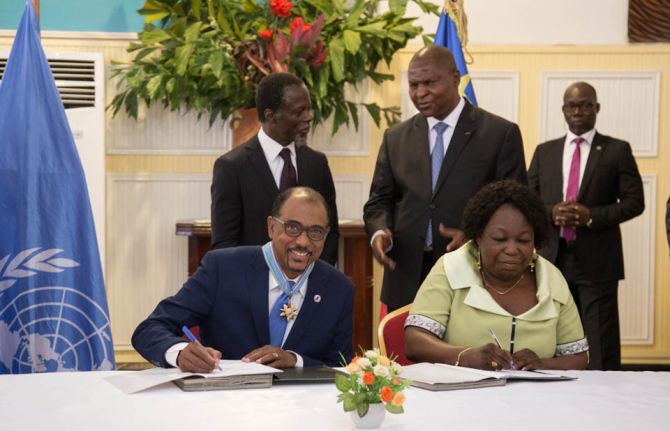
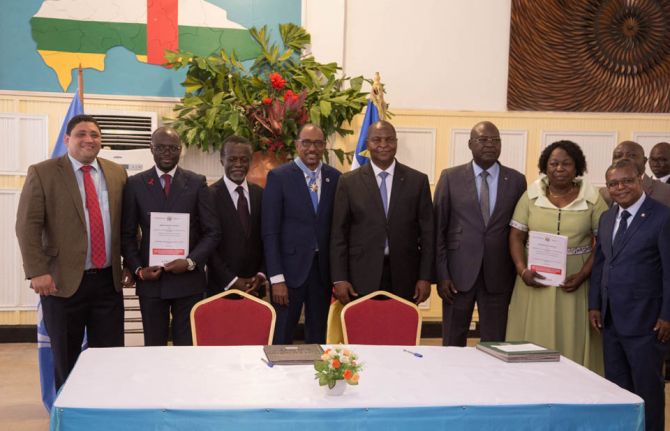
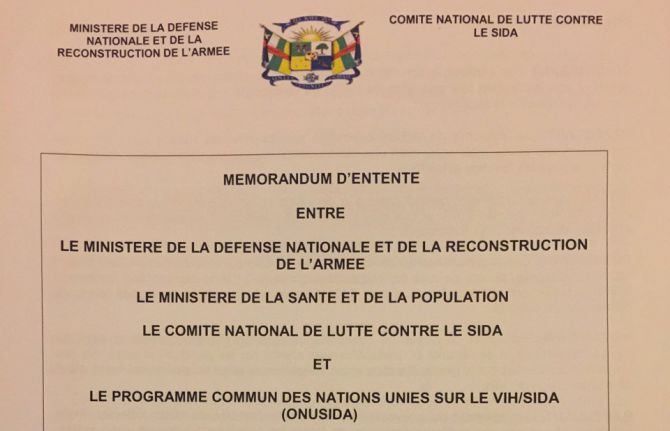
Press Release
UNAIDS to work with uniformed forces in the Central African Republic to end sexual violence and abuse and stop new HIV infections
09 October 2018 09 October 2018New initiative launched to engage the military and other uniformed personnel in HIV awareness, prevention and treatment and eliminate sexual and gender-based violence by defence and security forces
BANGUI/GENEVA, 9 October 2018—UNAIDS has signed a memorandum of understanding (MoU) with the Ministry of National Defence and Reconstruction of the Army, the Ministry of Health and Population and the National AIDS Committee of the Central African Republic. The aim of the MoU is to reduce new HIV infections within the military and other uniformed personnel, reduce sexual violence and abuse by security and defence forces and increase uptake of HIV treatment, care and support services.
The MoU comes at a critical time. The Central African Republic has the second highest HIV prevalence in central Africa, estimated at 4% in 2017. However, among uniformed personnel, HIV prevalence is double, at an estimated 7.8%. Knowledge of HIV among uniformed personnel in the Central African Republic is particularly low and reports of sexual abuse and violence by military personnel are widespread.
"We have a responsibility to protect all our people from violence and HIV, especially women and girls, who are the most vulnerable. By focusing on uniformed personnel, we aim to transform the relationship between the new army and the population, as a key to reconstruction,” said Faustin-Archange Touadéra, President of the Central African Republic.
Under the MoU the parties involved will mobilize national partners to respond to HIV and gender-based violence within the defence and security forces, reduce HIV prevalence and incidence and improve relations between the defence and security forces and the general population through integrated activities around HIV prevention and gender-based violence.
“This protocol is a first,” said Michel Sidibé, Executive Director of UNAIDS. “It translates Security Council resolution 1983 into concrete actions. It places prevention at the centre of our efforts to end gender-based violence as a cause and consequence of HIV. This is essential and complementary to all efforts to strengthen accountability for sexual violence in the Central African Republic.”
Special emphasis will be given to training and awareness-raising for defence and security forces using methods proven to be effective in reducing gender-based violence and preventing HIV. These include improving mechanisms to report sexual violence, support for survivors and ensuring access to effective HIV prevention tools. Social and psychosocial support programmes will also be made available for members of the defence and security forces and their families.
The main beneficiaries of the programmes and activities will be the defence and security forces in the Central African Republic, which include the military, the police, the gendarmerie, customs officials, water and forestry officers and the municipal police. The implementation of the MoU will also benefit the wider population through planned integrated activities between the military and civilians and through the impact of HIV prevention, treatment and care programmes and efforts to eliminate sexual and gender-based violence and abuse.
UNAIDS will provide leadership and technical support to the initiative and will mobilize its partners and Cosponsors, particularly organizations working on gender and health issues, to support the implementation of the activities outlined in the MoU. UNAIDS will also ensure effective collaboration between all project partners, including ensuring the active participation of civil society. It will also play a critical role in advocating for resources and supporting the monitoring, evaluation and documentation of the initiative.
The United Nations Multidimensional Integrated Stabilization Mission in the Central African Republic and the European Union Military Training Mission in the Central African Republic have committed to support the initiative.
The new commitments will play an important role in advancing the National Recovery and Peacebuilding Plan 2017–2021 in the Central African Republic and are part of ongoing efforts to implement United Nations Security Council resolution 1983, which underlines the importance of concerted efforts towards ending sexual and gender-based violence and responding to HIV in conflict and post-conflict settings.
HIV data for the Central African Republic in 2017:
- 160 000 [130 000–190 000] people were living with HIV
- 53% of people living with HIV knew their HIV status
- 32% of people living with HIV were accessing antiretroviral therapy
- 8700 [7600–11 000] people became newly infected with HIV
- 15 000 [12 000–17 000] people died from AIDS-related illnesses
UNAIDS
The Joint United Nations Programme on HIV/AIDS (UNAIDS) leads and inspires the world to achieve its shared vision of zero new HIV infections, zero discrimination and zero AIDS-related deaths. UNAIDS unites the efforts of 11 UN organizations—UNHCR, UNICEF, WFP, UNDP, UNFPA, UNODC, UN Women, ILO, UNESCO, WHO and the World Bank—and works closely with global and national partners towards ending the AIDS epidemic by 2030 as part of the Sustainable Development Goals. Learn more at unaids.org and connect with us on Facebook, Twitter, Instagram and YouTube.

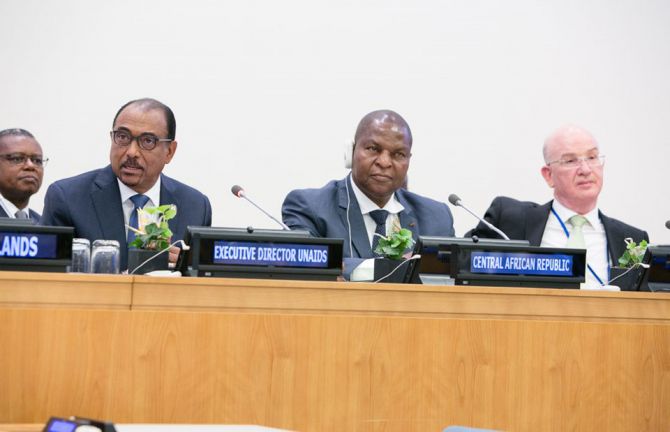
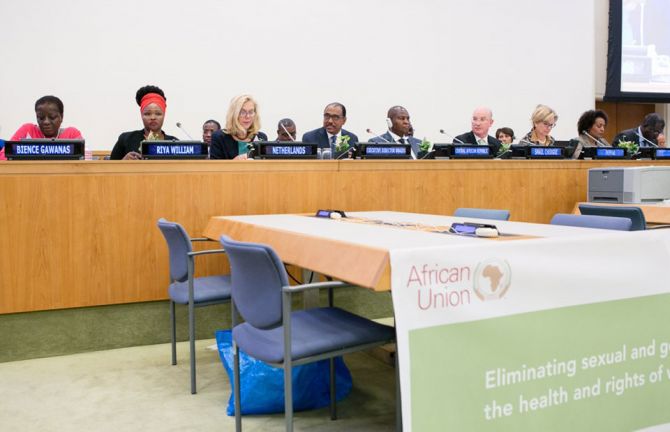
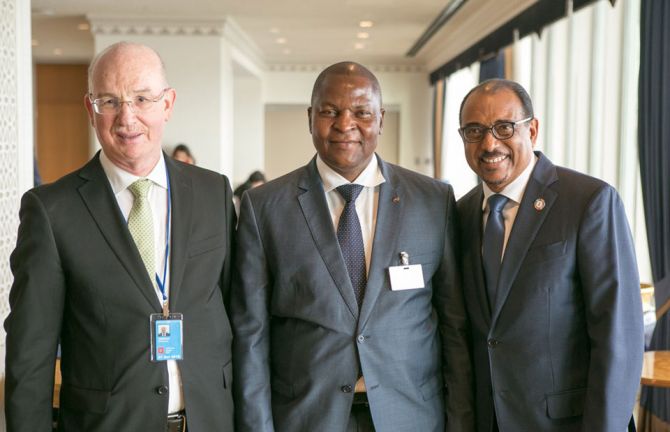
Press Release
The African Union and UNAIDS, as Chair of the H6 partnership, join forces to tackle sexual and gender-based violence and health in humanitarian crises
24 September 2018 24 September 2018Action-based partnership to support women and girls announced by health and political leaders at a high-level event at the 73rd Session of the United Nations General Assembly
GENEVA, 24 September 2018—UNAIDS, the Chair of the H6 partnership (six United Nations bodies working on health-related issues), and the African Union have pledged to enhance their collaboration to eliminate sexual and gender-based violence, prevent HIV and protect women’s health and rights in humanitarian settings.
A new programme of work on this common agenda was announced at a special high-level event held in New York, United States of America, on the margins of the 73rd Session of the United Nations General Assembly.
“We are gathered here to coordinate our efforts among the African Union and the United Nations to plan and intervene so that people's rights are protected, HIV is prevented and the right to health is promoted,” said Faustin-Archange Touadéra, the President of the Central African Republic, who chaired the meeting.
The rise in the frequency and scale of humanitarian crises is having a devastating impact, particularly on women and children. In 2017, around 68 million people were forcibly displaced globally as a result of persecution, conflict or generalized violence—an increase of 2.9 million from 2016 and a new record high.
“We know that it is time to act. More than 2 billion people live in countries affected by fragility, violence and conflict—most are women and girls. This is unacceptable. We need political visibility and intensified international cooperation to eliminate gender-based violence and protect the health of women and children in humanitarian settings,” said Michel Sidibé, Executive Director of UNAIDS and H6 Chair.
UNAIDS will support the African Union in developing a joint African Union–United Nations plan of action. The plan will include developing training and awareness tools for uniformed personnel in peacekeeping operations and ensuring better reporting rates on sexual exploitation and violence against women and girls.
“The partnership between the United Nations and the African Union provides an opportunity to reinforce each other’s work and employ joint and comprehensive responses to the needs of vulnerable populations in crisis situations,” said Smail Chergui, African Union Commissioner for Peace and Security.
Protecting the health and rights of women and young people will be critical to mitigating fragility, conflict and disaster. It is estimated that 60% of all preventable maternal deaths occur in humanitarian and conflict settings, which equates to nearly 500 deaths each day.
“In South Sudan, 52% of our young sisters are married before their 18th birthday. I urge leaders not to remain loudly quiet. We call for the inclusion of women in political processes. It is our bodies, our lives and our futures at stake. We have the right to the highest attainable standard of health, whether in conflict or not,” said Riya William Yuyada, Executive Director, Crown the Woman, South Sudan.
There are currently too few successful programmes to prevent gender-based violence during conflict and against refugee populations. Studies have shown that violence against women and girls increases during periods of conflict, with rape and other forms of sexual violence often being a common practice of war.
“It’s not about silencing the guns, we must recognize that women and children have a right to life and a right to health and a right to peace. This is where we should put our energies and time to make sure women and girls are protected,” said Bience Gawanas, the United Nations Secretary-General’s Special Adviser on Africa.
The United Nations’ 2030 Agenda for Sustainable Development and the African Union’s Agenda 2063 have created an important political window. The new commitments provide a timely opportunity to enhance collaboration on human security and humanitarian health, in the context of the recently adopted Joint United Nations–African Union Framework for Enhanced Partnership in Peace and Security.
“We must not explain why we are partnering, but why we are not partnering to eliminate sexual and gender-based violence and protect the health and rights of women and children in humanitarian settings. If we care about addressing the root causes of deprivation and poverty and abuse, women and girls are the heart of the matter,” said Sigrid Kaag, Minister of Foreign Trade and Development Cooperation, Netherlands.
Among the commitments made by UNAIDS and the African Union is to work to ensure that there is adequate funding to strengthen coordinated programme implementation for the responses to sexual exploitation and abuse and HIV in humanitarian settings. This enhanced cooperation between the African Union and the United Nations will be paramount to ensuring sustainable people-centred peace, security and development.
For more information on the new partnership between UNAIDS and the African Union, go to unaids.org
ADDITIONAL QUOTES
Deborah Birx, United States Global AIDS Coordinator and Special Representative for Global Health Diplomacy
It’s not just about the funds, it’s also about policies, laws and justice for girls and children, especially considering that 60% of the African continent is under 20 years old.
Elhadj As Sy, Secretary-General, International Federation of Red Cross and Red Crescent Societies
They need peace, they cry for peace, yearn for hope and try to retain the human dignity that they have lost along the way. It is the last piece of cloth, as we say in Africa, that is torn apart by gender- and sexual-based violence. Protection should not come as an afterthought.
Michaëlle Jean, Secretary-General, Organisation internationale de la Francophonie
Violence, rape, assault against women and young girls and boys is worldwide and can be likened to a weapon of mass destruction. We are here to do more against all forms of discrimination and crimes committed against women.
Pramilla Patten, Special Representative of the United Nations Secretary-General on Sexual Violence in Conflict
Shame, stigma and the risk of reprisals and lack of access to services lead to chronic underreporting. By isolating victims and cutting them off from medical care and support, stigma facilitates the spread of HIV.
Armed conflict creates conditions that allow HIV to flourish, including through rape, sexual slavery, and trafficking and exploitation, in environments where the rule of law and public health services may have collapsed.
Bintou Keita, United Nations Assistant Secretary-General for Peacekeeping Operations
Female peacekeepers are now being deployed to facilitate dialogue as well as women protection advisers for a more comprehensive approach to peacekeeping. Peacekeepers are also the ones who provide civilian peace and security, men and women who are committed to provide the best peace they can.
Lorena Castillo de Varela, First Lady of Panama
Since I started this journey with UNAIDS and the United Nations, two powerful words have guided me: zero discrimination. The challenges faced by women and children—particularly in humanitarian settings—are fuelled by stigma and discrimination, creating obstacles that block access to vital health services, such as HIV testing and life-saving medicines. Zero discrimination should fill every space in the world.
Martine Moise, First Lady of Haiti
Haiti has known its fair share of natural catastrophes, from earthquakes to hurricanes, making women and girls particularly vulnerable. In Haiti, gender-based violence is also all too common. I support fully the fight against violence against women and gender-based violence. This is a fight that must involve all.
Laure-Marie Kitanu, Coordinator of the Network of Women Living with HIV, Democratic Republic of the Congo
We have cried out to the international community for help in regard to HIV testing and prevention and we implore you to maintain the priority of peace and stability so that we have a long-lasting solution. We commend this African Union and UNAIDS initiative.
Written contribution from Ashraf El Nour, Director, International Organization of Migration Office to the United Nations, New York
The International Organization of Migration calls upon African Union governments and partners to ensure the fulfilment of the right to health for migrants, regardless of their status, in order to enhance the resilience of populations living in vulnerable conditions. The failure to do so not only jeopardizes the public health safety of vulnerable groups, but also that of entire communities where they reside.
UNAIDS
The Joint United Nations Programme on HIV/AIDS (UNAIDS) leads and inspires the world to achieve its shared vision of zero new HIV infections, zero discrimination and zero AIDS-related deaths. UNAIDS unites the efforts of 11 UN organizations—UNHCR, UNICEF, WFP, UNDP, UNFPA, UNODC, UN Women, ILO, UNESCO, WHO and the World Bank—and works closely with global and national partners towards ending the AIDS epidemic by 2030 as part of the Sustainable Development Goals. Learn more at unaids.org and connect with us on Facebook, Twitter, Instagram and YouTube.

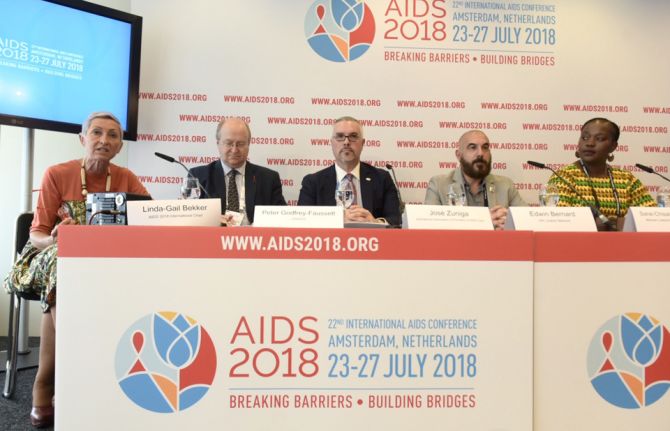
Press Release
Leading experts call on the criminal justice system to ensure science informs the application of the law in criminal cases related to HIV
25 July 2018 25 July 2018Prosecutions of people living with HIV for acts that pose no risk of HIV exposure or transmission prompt scientists to issue a statement urging the criminal justice system to use science when considering prosecution of HIV non-disclosure, exposure or transmission
AMSTERDAM/GENEVA, 25 July 2018—A group of 20 leading HIV scientists from around the world have issued a scientific consensus statement urging governments and people working in the legal and justice systems to pay close attention to the significant advances in HIV science to ensure that science informs the application of criminal law in cases related to HIV.
“Science has greatly advanced in recent years which has been critical in allowing countries to make evidence informed decisions in their HIV programming,” said Michel Sidibé, Executive Director of UNAIDS. “With all the new scientific advances now available we need to continue to use science as evidence to deliver justice. No one should face criminalization because of a lack of information or understanding by the justice system about the risks of HIV transmission.”
The expert group of scientists, convened by UNAIDS, the International Association of Providers of AIDS Care (IAPAC) and the International AIDS Society, warn that an overly broad and inappropriate application of criminal law against people living with HIV remains a serious concern across the globe. Around 73 countries have laws that criminalize HIV non-disclosure, exposure or transmission, and 39 countries have applied other criminal law provisions in similar cases.
“Many of these laws do not take into account measures that reduce HIV transmissibility, including condom use, and were enacted well before the preventive benefit of antiretroviral therapy or pre-exposure prophylaxis was fully characterized,” said José M. Zuniga, IAPAC President and Chief Executive Officer. “Most people living with HIV who know their status take steps to prevent transmitting HIV to others. Laws that specifically criminalize HIV non-disclosure, exposure, or transmission thus primarily exacerbate HIV-related stigma and decrease HIV service uptake.”
Most prosecutions have occurred based on perceived risk of HIV transmission through sexual activity. Some have also occurred for biting, spitting or even scratching. Prosecutions, and convictions, have often been influenced by a lack of knowledge or appreciation of scientific evidence regarding the possibility of transmission of the virus. In many instances, they have been influenced by deep-rooted stigma and fear associated with HIV, which still exists despite the huge advances in HIV treatment and prevention.
“We support this globally relevant expert consensus statement, for which we have been long-time advocates,” said HIV Justice Network’s Senior Policy Analyst Sally Cameron, on behalf of the Steering Committee of HIV Justice Worldwide, a global civil society coalition campaigning to end unjust prosecutions. “HIV criminalization is a growing global phenomenon that unfairly targets people living with HIV through criminal prosecutions and harsh penalties. This welcome statement makes the case that our current understanding of HIV science, alongside key human rights and legal principles, does not support this miscarriage of justice.”
The peer-reviewed consensus statement, endorsed by 70 additional scientists from around the world, was released today in the Journal of the International AIDS Society. It describes scientific evidence on the possibility of HIV transmission under various circumstances, the long-term impact of HIV infection and the means of proving HIV transmission so that it is better understood in criminal law contexts.
Based on a detailed analysis of the best available scientific evidence on HIV transmission and treatment effectiveness, the statement notes that there is no possibility of HIV transmission through saliva as a result of biting or spitting, even where saliva contains small quantities of blood. There is no to negligible possibility of HIV transmission where a condom is used correctly during sex, or where a partner living with HIV has an undetectable viral load.
In addition, effective antiretroviral therapy, low viral load, the use of pre-exposure prophylaxis (antiretroviral drugs taken by an HIV-negative person before a possible exposure), or post-exposure prophylaxis (antiretroviral medicines taken after a possible exposure) all significantly reduce the possibility of HIV transmission.
International guidance on HIV in the context of the criminal law recommends that “proof of causation, in relation to HIV transmission, should always be based on evidence derived from a number of relevant sources, including medical records, rigorous scientific methods and sexual history” (Ending overly broad criminalization of HIV non-disclosure, exposure and transmission: critical scientific, medical and legal considerations).
The experts recommend strongly that more caution be exercised when considering criminal prosecution, including careful appraisal of current scientific evidence on HIV risk and harms. The consensus statement is expected to help policymakers, prosecutors and courts be guided by the best available science and thereby avoid the misuse of the criminal law, as is currently happening in many countries worldwide.
Read the full Expert Consensus Statement on the Science of HIV in the Context of Criminal Law
UNAIDS
The Joint United Nations Programme on HIV/AIDS (UNAIDS) leads and inspires the world to achieve its shared vision of zero new HIV infections, zero discrimination and zero AIDS-related deaths. UNAIDS unites the efforts of 11 UN organizations—UNHCR, UNICEF, WFP, UNDP, UNFPA, UNODC, UN Women, ILO, UNESCO, WHO and the World Bank—and works closely with global and national partners towards ending the AIDS epidemic by 2030 as part of the Sustainable Development Goals. Learn more at unaids.org and connect with us on Facebook, Twitter, Instagram and YouTube.
Press centre
Download the printable version (PDF)

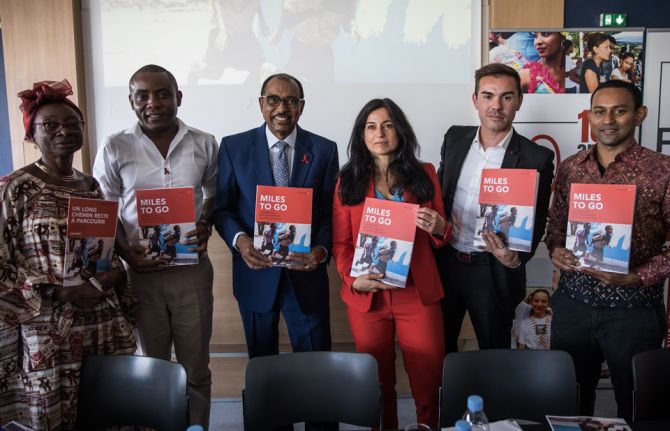
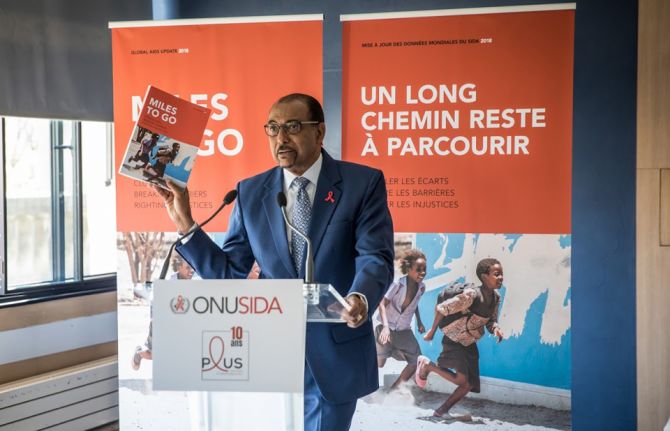
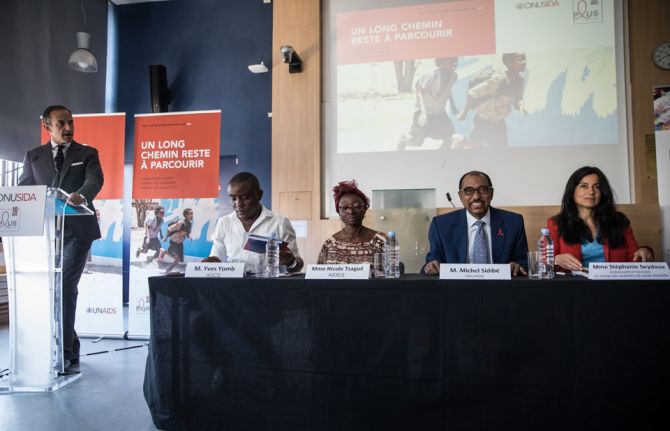
Press Release
UNAIDS warns that progress is slowing and time is running out to reach the 2020 HIV targets
24 July 2018 24 July 2018New HIV infections are rising in around 50 countries, AIDS-related deaths are not falling fast enough and flat resources are threatening success. Half of all new HIV infections are among key populations and their partners, who are still not getting the services they need
PARIS/GENEVA, 18 July 2018—UNAIDS is issuing countries with a stark wake-up call. In a new report, launched today in Paris, France, at an event co-hosted with Coalition PLUS, UNAIDS warns that the global response to HIV is at a precarious point. At the halfway point to the 2020 targets, the report, Miles to go—closing gaps, breaking barriers, righting injustices, warns that the pace of progress is not matching global ambition. It calls for immediate action to put the world on course to reach critical 2020 targets.
“We are sounding the alarm,” said Michel Sidibé, Executive Director of UNAIDS. “Entire regions are falling behind, the huge gains we made for children are not being sustained, women are still most affected, resources are still not matching political commitments and key populations continue to be ignored. All these elements are halting progress and urgently need to be addressed head-on.”
HIV prevention crisis
Global new HIV infections have declined by just 18% in the past seven years, from 2.2 million in 2010 to 1.8 million in 2017. Although this is nearly half the number of new infections compared to the peak in 1996 (3.4 million), the decline is not quick enough to reach the target of fewer than 500 000 by 2020.
The reduction in new HIV infections has been strongest in the region most affected by HIV, eastern and southern Africa, where new HIV infections have been reduced by 30% since 2010. However, new HIV infections are rising in around 50 countries. In eastern Europe and central Asia the annual number of new HIV infections has doubled, and new HIV infections have increased by more than a quarter in the Middle East and North Africa over the past 20 years.
Treatment scale-up should not be taken for granted
Due to the impact of antiretroviral therapy roll-out, the number of AIDS-related deaths is the lowest this century (940 000), having dropped below 1 million for the first time in 2016. Yet, the current pace of decline is not fast enough to reach the 2020 target of fewer than 500 000 AIDS-related deaths.
In just one year, an additional 2.3 million people were newly accessing treatment. This is the largest annual increase to date, bringing the total number of people on treatment to 21.7 million. Almost 60% of the 36.9 million people living with HIV were on treatment in 2017, an important achievement, but to reach the 30 million target there needs to be an annual increase of 2.8 million people, and there are indications that the rate of scale-up is slowing down.
West and central Africa lagging behind
Just 26% of children and 41% of adults living with HIV had access to treatment in western and central Africa in 2017, compared to 59% of children and 66% of adults in eastern and southern Africa. Since 2010, AIDS-related deaths have fallen by 24% in western and central Africa, compared to a 42% decline in eastern and southern Africa.
Nigeria has more than half (51%) of the HIV burden in the region and there has been little progress in reducing new HIV infections in recent years. New HIV infections declined by only 5% (9000) in seven years (from 179 000 to 170 000) and only one in three people living with HIV is on treatment (33%), although HIV treatment coverage has increased from just 24% two years ago.
Progress for children has slowed
The report shows that the gains made for children are not being sustained. New HIV infections among children have declined by only 8% in the past two years, only half (52%) of all children living with HIV are getting treatment and 110 000 children died of AIDS-related illnesses in 2017. Although 80% of pregnant women living with HIV had access to antiretroviral medicines to prevent transmission of HIV to their child in 2017, an unacceptable 180 000 children acquired HIV during birth or breastfeeding—far away from the target of fewer than 40 000 by the end of 2018.
“One child becoming infected with HIV or one child dying of AIDS is one too many,” said Mr Sidibé. “Ending the AIDS epidemic is not a foregone conclusion and the world needs to heed this wake-up call and kick-start an acceleration plan to reach the targets.”
Key populations account for almost half of all new HIV infections worldwide
The report also shows that key populations are not being considered enough in HIV programming. Key populations and their sexual partners account for 47% of new HIV infections worldwide and 97% of new HIV infections in eastern Europe and central Asia, where one third of new HIV infections are among people who inject drugs.
“The right to health for all is non-negotiable,” said Mr Sidibé. “Sex workers, gay men and other men who have sex with men, prisoners, migrants, refugees and transgender people are more affected by HIV but are still being left out from HIV programmes. More investments are needed in reaching these key populations.”
Half of all sex workers in Eswatini, Lesotho, Malawi, South Africa and Zimbabwe are living with HIV. The risk of acquiring HIV is 13 times higher for female sex workers, 27 times higher among men who have sex with men, 23 times higher among people who inject drugs and 12 times higher for transgender women.
“Communities are echoing UNAIDS’ call,” said Vincent Pelletier, positive leader and Executive Director of Coalition PLUS. “We need universal access to adapted prevention services, and protection from discrimination. We call upon world leaders to match commitments with funding, in both donor and implementing countries.”
Stigma and discrimination persists
Discrimination by health-care workers, law enforcement, teachers, employers, parents, religious leaders and community members is preventing young people, people living with HIV and key populations from accessing HIV prevention, treatment and other sexual and reproductive health services.
Across 19 countries, one in five people living with HIV responding to surveys reported being denied health care and one in five people living with HIV avoided visiting a health facility for fear of stigma or discrimination related to their HIV status. In five of 13 countries with available data, more than 40% of people said they think that children living with HIV should not be able to attend school with children who are HIV-negative.
New agenda needed to stop violence against women
In 2017, around 58% of all new HIV infections among adults more than 15 years old were among women and 6600 young women between the ages of 15 and 24 years became infected with HIV every week. Increased vulnerability to HIV has been linked to violence. More than one in three women worldwide have experienced physical or sexual violence, often at the hands of their intimate partners.
“Inequality, a lack of empowerment and violence against women are human rights violations and are continuing to fuel new HIV infections,” said Mr Sidibé. “We must not let up in our efforts to address and root out harassment, abuse and violence, whether at home, in the community or in the workplace.”
90–90–90 can and must be achieved
There has been progress towards the 90–90–90 targets. Three quarters (75%) of all people living with HIV now know their HIV status; of the people who know their status, 79% were accessing treatment in 2017, and of the people accessing treatment, 81% had supressed viral loads.
Six countries, Botswana, Cambodia, Denmark, Eswatini, Namibia and the Netherlands, have already reached the 90–90–90 targets and seven more countries are on track. The largest gap is in the first 90; in western and central Africa, for example, only 48% of people living with HIV know their status.
A big year for the response to tuberculosis
There have been gains in treating and diagnosing HIV among people with tuberculosis (TB)—around nine out of 10 people with TB who are diagnosed with HIV are on treatment. However, TB is still the biggest killer of people living with HIV and three out of five people starting HIV treatment are not screened, tested or treated for TB. The United Nations High-Level Meeting on Tuberculosis in September 2018 is an opportunity to bolster momentum around reaching the TB/HIV targets.
The cost of inaction
Around US$ 20.6 billion was available for the AIDS response in 2017—a rise of 8% since 2016 and 80% of the 2020 target set by the United Nations General Assembly. However, there were no significant new commitments and as a result the one-year rise in resources is unlikely to continue. Achieving the 2020 targets will only be possible if investments from both donor and domestic sources increase.
Ways forward
From townships in southern Africa to remote villages in the Amazon to mega-cities in Asia, the dozens of innovations contained within the pages of the report show that collaboration between health systems and individual communities can successfully reduce stigma and discrimination and deliver services to the vast majority of the people who need them the most.
These innovative approaches continue to drive the solutions needed to achieve the 2020 targets. When combination HIV prevention—including condoms and voluntary medical male circumcision—is pursued at scale, population-level declines in new HIV infections are achieved. Oral pre-exposure prophylaxis (PrEP) is having an impact, particularly among key populations. Offering HIV testing and counselling to family members and the sexual partners of people diagnosed with HIV has significantly improved testing access.
Eastern and southern Africa has seen significant domestic and international investments coupled with strong political commitment and community engagement and is showing significant progress in achieving the 2020 targets.
“For every challenge there is a solution,” said Mr Sidibé. “It is the responsibility of political leaders, national governments and the international community to make sufficient financial investments and establish the legal and policy environments needed to bring the work of innovators to the global scale. Doing so will create the momentum needed to reach the targets by 2020.”
In 2017, an estimated:
36.9 million [31.1 million–43.9 million] people globally were living with HIV
21.7 million [19.1 million–22.6 million] people were accessing treatment
1.8 million [1.4 million–2.4 million] people became newly infected with HIV
940 000 [670 000–1.3 million] people died from AIDS-related illnesses
UNAIDS
The Joint United Nations Programme on HIV/AIDS (UNAIDS) leads and inspires the world to achieve its shared vision of zero new HIV infections, zero discrimination and zero AIDS-related deaths. UNAIDS unites the efforts of 11 UN organizations—UNHCR, UNICEF, WFP, UNDP, UNFPA, UNODC, UN Women, ILO, UNESCO, WHO and the World Bank—and works closely with global and national partners towards ending the AIDS epidemic by 2030 as part of the Sustainable Development Goals. Learn more at unaids.org and connect with us on Facebook, Twitter, Instagram and YouTube.

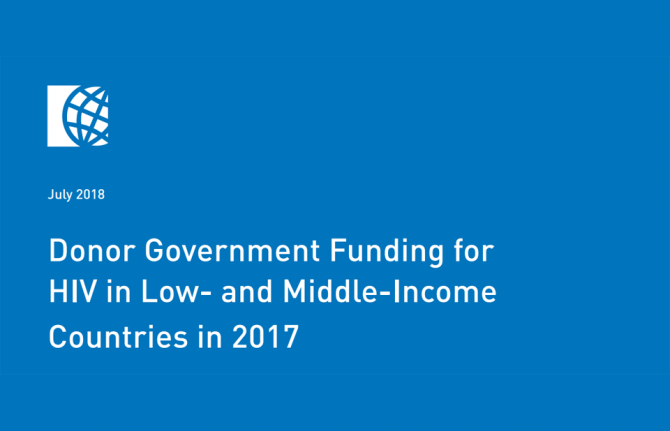
Press Release
Kaiser/UNAIDS study finds donor government funding for HIV rose to US$ 8.1 billion in 2017 due to shift in timing of United States support
18 July 2018 18 July 2018Most donor governments decreased support
GENEVA/MENLO PARK, UNITED STATES, 18 July 2018—Donor government disbursements to combat HIV in low- and middle-income countries increased by 16%, from US$ 7 billion in 2016 to US$ 8.1 billion in 2017, although the higher total stems largely from the timing of funding from the United States of America and is not expected to last, a new report from the Kaiser Family Foundation and UNAIDS finds.
The increase follows two years of declines in donor support for HIV and results largely from a boost by the United States, the world’s largest donor nation, which increased its disbursement from US$ 4.9 billion in 2016 to US$ 5.9 billion 2017, including funds appropriated but not spent from previous years. New United States appropriations have been flat for several years, suggesting that future disbursements will likely fall back to prior levels.
While eight of 14 donor governments reduced their spending on global HIV efforts in 2017, increases by the United States and five other donors more than offset these declines. Bilateral aid went up, due to the United States increase. Multilateral contributions to the Global Fund to Fight AIDS, Tuberculosis and Malaria (Global Fund) also increased.
Donor government funding supports HIV care and treatment, prevention and other services in low- and middle-income countries. The report notes that without new commitments by other donor governments, however, future funding for HIV is likely to return to lower levels.
“UNAIDS is deeply concerned that a lack of sufficient resources will mean more deaths and more new HIV infections that can be prevented,” said Michel Sidibé, UNAIDS Executive Director. “Even a 20% cut in international funding would be catastrophic for the 44 countries that rely on international assistance for at least 75% of their national HIV responses.”
“This year’s increase is more an anomaly than a trend, as it doesn’t reflect new resources,” said Kaiser Family Foundation Vice President Jen Kates, Director of Global Health and HIV Policy. “Going forward, the urgency to identify alternative funding sources grows if the global community wants to reach its HIV targets.”
After the United States, the governments making the largest contributions to global HIV efforts include the United Kingdom of Great Britain and Northern Ireland (US$ 743.9 million), France (US$ 267.7 million), the Netherlands (US$ 202.6 million) and Germany (US$ 161.9 million).
The new report, produced as a long-standing partnership between the Kaiser Family Foundation and UNAIDS, provides the latest data available on donor government funding based on data provided by governments. It includes their bilateral assistance to low- and middle-income countries and contributions to the Global Fund as well as UNITAID. Donor government funding refers to disbursements, or payments, made by donors. Donor contributions to multilateral organizations are counted as part of their disbursements.
UNAIDS
The Joint United Nations Programme on HIV/AIDS (UNAIDS) leads and inspires the world to achieve its shared vision of zero new HIV infections, zero discrimination and zero AIDS-related deaths. UNAIDS unites the efforts of 11 UN organizations—UNHCR, UNICEF, WFP, UNDP, UNFPA, UNODC, UN Women, ILO, UNESCO, WHO and the World Bank—and works closely with global and national partners towards ending the AIDS epidemic by 2030 as part of the Sustainable Development Goals. Learn more at unaids.org and connect with us on Facebook, Twitter, Instagram and YouTube.
The Kaiser Family Foundation
Filling the need for trusted information on national health issues, the Kaiser Family Foundation is a nonprofit organization based in Menlo Park, California.
Contact
UNAIDSSophie Barton-Knott
tel. +41 22 791 1697
bartonknotts@unaids.org
Kaiser Family Foundation
Tiffany Ford Fields
tel. +1 (202) 347-5270
tiffanyf@kff.org
Press centre
Download the printable version (PDF)

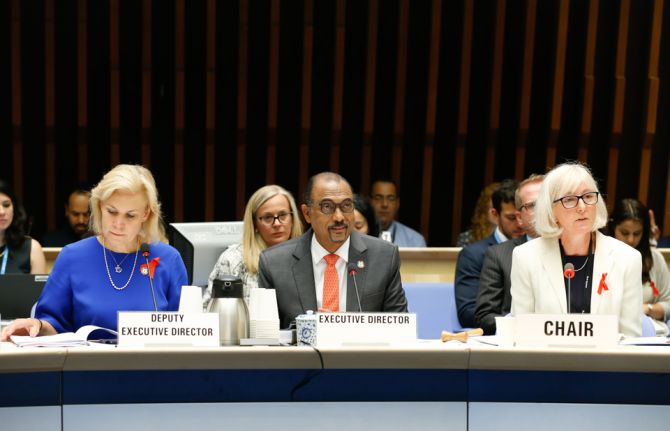
Press Release
UNAIDS Board reiterates its strong commitment to the mandate of UNAIDS towards ending the AIDS epidemic by 2030
29 June 2018 29 June 2018Board members back measures for UNAIDS to inspire United Nations reform in ensuring the highest standards of integrity and dignity at work and encourage all countries to close the funding gap in the global HIV response, including fully funding UNAIDS.
GENEVA, 29 June 2018—At UNAIDS’ 42nd Programme Coordinating Board meeting, which took place in Geneva, Switzerland, on 26–28 June, Board members expressed their support for UNAIDS and underscored the critical role that the organization has to play in ending the AIDS epidemic.
In his opening address, the Executive Director of UNAIDS, Michel Sidibé, welcomed the Board’s support and reiterated the importance of focusing on the challenges and opportunities ahead in reaching the 2020 Fast-Track commitments agreed by the United Nations General Assembly. “The 37 million people who are living with HIV today, along with the 1.8 million who will acquire HIV over the course of this year, are counting on us. AIDS is not over—but it can be—and at UNAIDS we are fully committed to ending the AIDS epidemic.”
The Board requested UNAIDS to continue to strengthen joint and collaborative action at the country level as part of United Nations reform efforts. Members also requested UNAIDS to continue to strengthen performance reporting aligned to national targets, with a focus on impact, results and the identification of areas which are off-track and bottlenecks, with actions to address those issues.
The Board encouraged donor governments to make multiyear contributions and release their contributions towards the 2016–2021 Unified Budget, Results and Accountability Framework as soon as possible to fully fund the 2018–2019 UNAIDS budget of US$ 484 million. During the meeting, an important funding announcement to UNAIDS was made by Australia, which confirmed it was pledging nearly US$ 1 million in additional funds for HIV prevention in the Asia–Pacific region.
Board members expressed their support for the measures that UNAIDS is putting in place to address harassment in the workplace. The Board heard Mr Sidibé’s commitment to lead change as he outlined the proactive actions under way at UNAIDS to prevent sexual harassment, unethical workplace behaviour and all forms of abuse.
“UNAIDS is taking concrete actions to ensure zero tolerance and zero impunity for harassment and abuse of authority,” said Mr Sidibé. “I am committed to ensuring a workplace where everyone can work with respect and dignity.”
Measures include a five-point plan to ensure that all forms of harassment and abuse of authority are identified early, dealt with swiftly and effectively with due process and to ensure that survivors and whistle-blowers are protected. UNAIDS has also set up an anonymous and confidential Integrity Hotline, released its new Gender Action Plan 2018–2023 and called for the establishment of an Independent Expert Panel on harassment to provide policy recommendations on how UNAIDS can improve its response and identify areas where reform is needed. The Board welcomed this request and has moved quickly to establish terms of reference for the independent expert panel. The panel will report to the Board to ensure that the oversight of the panel remains entirely independent.
The UNAIDS Staff Association made a statement to the Board to emphasise the genuine will and commitment of the staff to bring about positive change. The Staff Association also presented data from a recent staff survey in which 89% of staff responding said that their commitment to the goals of the organization is what motivates them to come to work each day.
During the meeting, the Board heard from several representatives of key populations on a variety of issues, including ensuring respect and dignity in the use of terminology, funding and support and meaningful consultation with civil society, respect for human rights and gender equality. In addition, concerns were raised about the specific and increased needs of displaced people in humanitarian settings and of people in prison settings.
Mr Sidibé invited the First Lady of Panama and UNAIDS Special Ambassador for AIDS in Latin America, Lorena Castillo de Varela, to present her groundbreaking work on zero discrimination to the Board.
On the final day of the meeting, the Board participated in a thematic session on ending tuberculosis (TB) and AIDS. Around 10 million new cases of TB occur every year and TB remains the leading cause of death among people living with HIV, accounting for one in every three AIDS-related deaths. The participants discussed the urgent need to scale up joint efforts to address the dual, intertwined epidemics of TB and HIV.
Representatives of United Nations Member States, international organizations, civil society and nongovernmental organizations attended the three-day meeting, which was chaired by Anna Wechsberg, Policy Director for the Department for International Development of the United Kingdom of Great Britain and Northern Ireland, with Cui Li, Vice-Minister of National Health and Family, China, serving as Vice-Chair and Algeria as Rapporteur.
The UNAIDS Executive Director’s report to the Board and the Board’s decisions can be found at http://www.unaids.org/en/whoweare/pcb/42.
Quotes
We are aware of the efforts undertaken by UNAIDS to strengthen policies to prevent and manage incidents of sexual exploitation and abuse and harassment. We commend UNAIDS and its Executive Director for this.
It is important to recognise all the staff at UNAIDS and in the Cosponsors, who come to work every day to end the HIV/AIDS epidemic.
We wish to reiterate our strong commitment to the mandate of UNAIDS towards ending the AIDS epidemic by 2030 and to working with the Secretariat and its staff to stay on mission and overcome the present challenges.
The United States requires for its work in HIV/AIDS a strong and healthy UNAIDS. Why? Because the Secretariat must speak with authority on issues facing key populations and women around the globe to ensure host governments respond to the essential issues faced by the populations.
We reaffirm our support to UNAIDS' important role in guiding the international AIDS response and will actively support the process designed to ensure an inclusive environment with zero tolerance for all forms of harassment at the UNAIDS Secretariat. We would like to stress that the Joint Programme remains a unique model in the United Nations and is well set to adapt to the changes needed to contribute to the implementation of the 2030 Agenda, in line with the United Nations development system reform, as the Joint Action Plan shows.
UNAIDS has always been at the forefront of the United Nations system. We congratulate the UNAIDS Secretariat for its fast and active responses to all the challenges faced and encourage the Joint Programme to continue to act as a champion for gender equality and the empowerment of women across the United Nations system.
For the African region, HIV/AIDS remains a major concern, with huge socioeconomic impact. We have made groundbreaking progress in the past decade and we need the momentum to be sustained towards the very ambitious but attainable goal of ending AIDS by 2030. As we move forward in this discussion we call on Board members, and in fact the whole world, not to lose sight of this very important aim of UNAIDS.
Being a Fast-Track country, we appreciate the positive impact that this organization is having on the ground and we therefore call on all stakeholders not to lose sight of the centrality of UNAIDS in the HIV/AIDS response.
Although we believe that everyone in this room is committed to achieve health for all, to win this epidemic will require more: we need to see your political leadership translated in human and financial resources at all levels, so we can really advance toward a consistent and sustainable HIV response.
There is a concern that funding civil society is not supported appropriately, and that it represents a lack of vision of those who are committed to Ending AIDS. And we will not reach the people that are left behind, we will not be able to negotiate or do the advocacy work with governments for the latest prevention or treatment measures and we might not be able to enhance work on the structural barriers. By now we have all learned that for better business of HIV prevention and treatment it is important to invest in the communities.
This is the UNAIDS we know—in its strengths and in its shortcomings. We are a group of people committed to the AIDS response and the people we serve. We are proud of our achievements. We recognize the courage of our peers at all levels of the organization. Like any organization, there are areas where we can and must do better. But where we see problems, we identify solutions.
UNAIDS
The Joint United Nations Programme on HIV/AIDS (UNAIDS) leads and inspires the world to achieve its shared vision of zero new HIV infections, zero discrimination and zero AIDS-related deaths. UNAIDS unites the efforts of 11 UN organizations—UNHCR, UNICEF, WFP, UNDP, UNFPA, UNODC, UN Women, ILO, UNESCO, WHO and the World Bank—and works closely with global and national partners towards ending the AIDS epidemic by 2030 as part of the Sustainable Development Goals. Learn more at unaids.org and connect with us on Facebook, Twitter, Instagram and YouTube.
Press centre
Download the printable version (PDF)

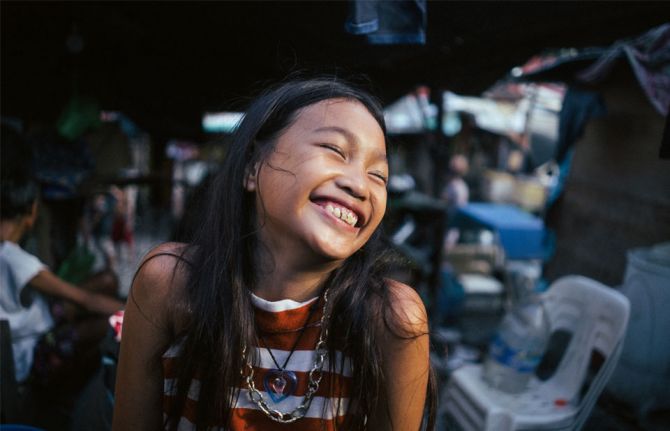
Press Release
What if … Zero Discrimination Day 2018
01 March 2018 01 March 2018GENEVA, 1 March 2018—Discrimination is often based on misinformation or fear of the unknown. By reflecting on people in everyday situations, on Zero Discrimination Day, 1 March, UNAIDS is challenging people to recognize where everyday discrimination takes place and to take action to stop it.
This year’s Zero Discrimination Day campaign invites people to ask themselves “What if …” and to reflect upon their own actions.
What if the person you bought your vegetables from was living with HIV? Would you buy tomatoes from him?
What if your neighbour had tuberculosis? Would you stop to chat?
Allowing discrimination to continue is not only wrong, it is bad for communities, bad for the economy and bad for the future. Discriminating against women affects food production: women make up 43% of the agriculture workforce in developing countries and yet only 5% are able to access agricultural advisory services.
“We will never guarantee the right to health and end the AIDS epidemic if we exclude people,” said the Executive Director of UNAIDS, Michel Sidibé. “However, huge structural barriers stand in the way of the health and well-being of millions.”
No one should ever be discriminated against because of their HIV status, age, sex, gender identity, sexual orientation, disability, race, ethnicity, language, geographical location or migrant status, or for any other reason. Unfortunately, however, discrimination continues to undermine efforts to achieve a more just and equitable world. People face discrimination every day based on who they are or what they do.
Access to health services is essential to prevent and treat HIV. And yet approximately one in five people living with HIV reported avoiding going to a local clinic or hospital because they feared stigma or discrimination related to their HIV status.
Discrimination will not disappear without actively addressing the ignorance, practices and beliefs that fuel it. Ending discrimination requires action from everyone. Zero Discrimination Day is an opportunity to highlight how everyone can be a part of the transformation and take a stand towards a more fair and just society.
Zero Discrimination Day has been observed every year since 1 March 2014.
Join us for #zerodiscrimination.
UNAIDS
The Joint United Nations Programme on HIV/AIDS (UNAIDS) leads and inspires the world to achieve its shared vision of zero new HIV infections, zero discrimination and zero AIDS-related deaths. UNAIDS unites the efforts of 11 UN organizations—UNHCR, UNICEF, WFP, UNDP, UNFPA, UNODC, UN Women, ILO, UNESCO, WHO and the World Bank—and works closely with global and national partners towards ending the AIDS epidemic by 2030 as part of the Sustainable Development Goals. Learn more at unaids.org and connect with us on Facebook, Twitter, Instagram and YouTube.
Press centre
Download the printable version (PDF)
